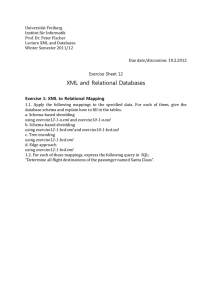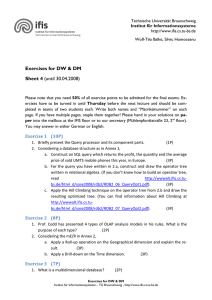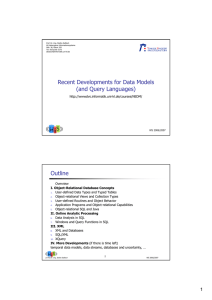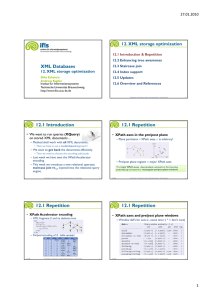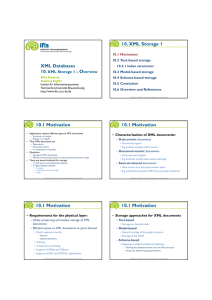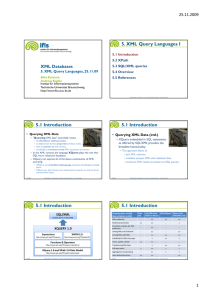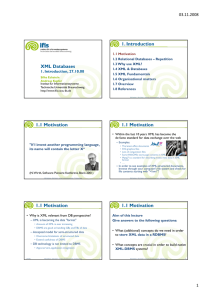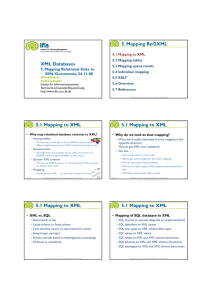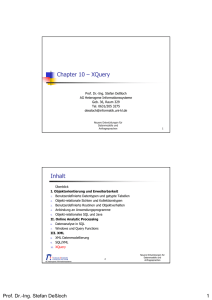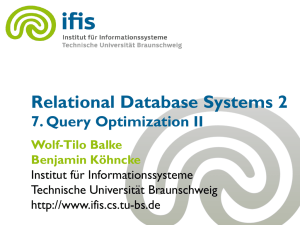6. XML Query Languages II 6.1 Introduction 6.1 Introduction 6.1
Werbung
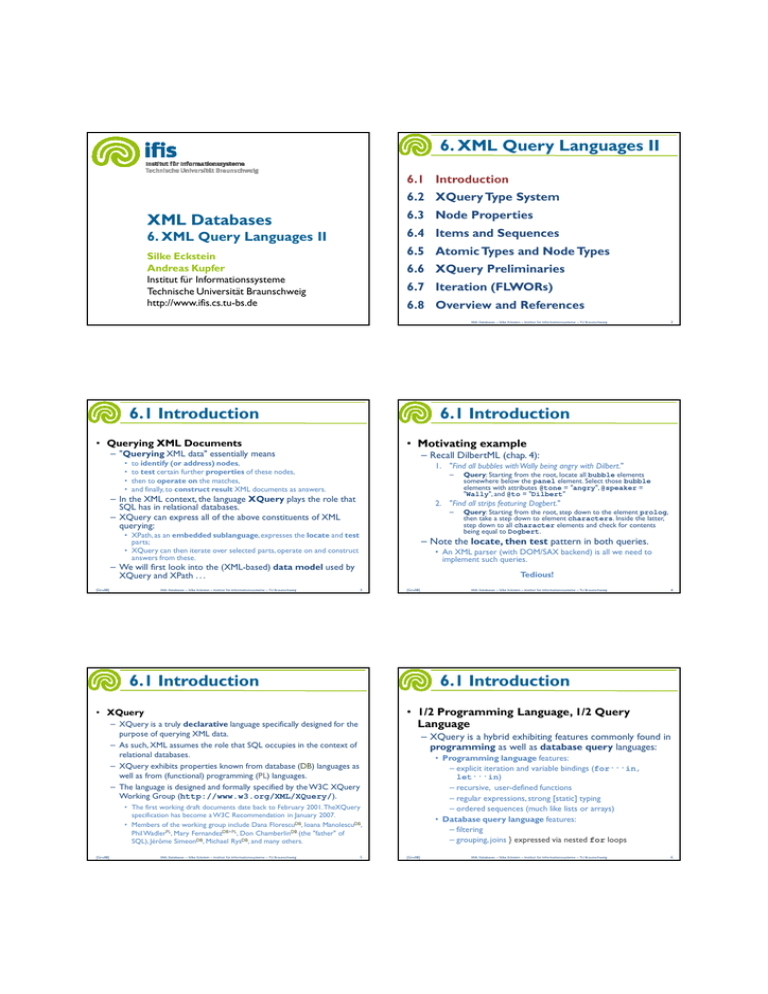
6. XML Query Languages II
6.1 Introduction
6.2 XQuery Type System
6.3 Node Properties
XML Databases
6.4 Items and Sequences
6. XML Query Languages II
6.5 Atomic Types and Node Types
Silke Eckstein
Andreas Kupfer
Institut für Informationssysteme
Technische Universität Braunschweig
http://www.ifis.cs.tu-bs.de
6.6 XQuery Preliminaries
6.7 Iteration (FLWORs)
6.8 Overview and References
XML Databases – Silke Eckstein – Institut für Informationssysteme – TU Braunschweig
6.1 Introduction
6.1 Introduction
• Motivating example
• Querying XML Documents
– "Querying XML data" essentially means
•
•
•
•
– Recall DilbertML (chap. 4):
to identify (or address) nodes,
to test certain further properties of these nodes,
then to operate on the matches,
and finally, to construct result XML documents as answers.
1. "Find all bubbles with Wally being angry with Dilbert."
–
– In the XML context, the language XQuery plays the role that
SQL has in relational databases.
– XQuery can express all of the above constituents of XML
querying:
–
• An XML parser (with DOM/SAX backend) is all we need to
implement such queries.
Tedious!
3
[Gru08]
6.1 Introduction
4
• 1/2 Programming Language, 1/2 Query
Language
– XQuery is a truly declarative language specifically designed for the
purpose of querying XML data.
– As such, XML assumes the role that SQL occupies in the context of
relational databases.
– XQuery exhibits properties known from database (DB) languages as
well as from (functional) programming (PL) languages.
– The language is designed and formally specified by the W3C XQuery
Working Group (http://www.w3.org/XML/XQuery/).
– XQuery is a hybrid exhibiting features commonly found in
programming as well as database query languages:
• Programming language features:
– explicit iteration and variable bindings (for···in,
let···in)
– recursive, user-defined functions
– regular expressions, strong [static] typing
– ordered sequences (much like lists or arrays)
• Database query language features:
– filtering
– grouping, joins } expressed via nested for loops
• The first working draft documents date back to February 2001. TheXQuery
specification has become a W3C Recommendation in January 2007.
• Members of the working group include Dana FlorescuDB, Ioana ManolescuDB,
Phil WadlerPL, Mary FernandezDB+PL, Don ChamberlinDB (the "father" of
SQL), Jérôme SimeonDB, Michael RysDB, and many others.
XML Databases – Silke Eckstein – Institut für Informationssysteme – TU Braunschweig
XML Databases – Silke Eckstein – Institut für Informationssysteme – TU Braunschweig
6.1 Introduction
• XQuery
[Gru08]
Query: Starting from the root, step down to the element prolog,
then take a step down to element characters. Inside the latter,
step down to all character elements and check for contents
being equal to Dogbert.
– Note the locate, then test pattern in both queries.
– We will first look into the (XML-based) data model used by
XQuery and XPath . . .
XML Databases – Silke Eckstein – Institut für Informationssysteme – TU Braunschweig
Query: Starting from the root, locate all bubble elements
somewhere below the panel element. Select those bubble
elements with attributes @tone = "angry", @speaker =
"Wally", and @to = "Dilbert"
2. "Find all strips featuring Dogbert."
• XPath, as an embedded sublanguage, expresses the locate and test
parts;
• XQuery can then iterate over selected parts, operate on and construct
answers from these.
[Gru08]
2
5
[Gru08]
XML Databases – Silke Eckstein – Institut für Informationssysteme – TU Braunschweig
6
6.1 Introduction
6. XML Query Languages II
• History of XQuery
6.1 Introduction
6.2 XQuery Type System
6.3 Node Properties
6.4 Items and Sequences
6.5 Atomic Types and Node Types
6.6 XQuery Preliminaries
6.7 Iteration (FLWORs)
6.8 Overview and References
[Gru08]
7
XML Databases – Silke Eckstein – Institut für Informationssysteme – TU Braunschweig
6.2 XQuery Type System
6.2 XQuery Type System
• XQuery data model (1)
• The XQuery Data Model
– Like for any other database query language, before we
talk about the operators of the language, we have to
specify exactly what it is that these operate on . . .
Which aspects of XML data are relevant to queries?
<x>Symbols like &amp; and ![CDATA[<]]> can be
tricky in XML.</x>
• XQuery (and the other languages) use an abstract view of
the XML data, the so-called XQuery data model.
– What is an adequate representation of XML element x?
DOM style. . . ?
Data Model (DM)
The XQuery DM determines which aspects of an XML document
may be inspected and manipulated by an XQuery query.
XML Databases – Silke Eckstein – Institut für Informationssysteme – TU Braunschweig
9
[Gru08]
An XML element containing an integer
<x>Symbols like &amp; and ![CDATA[<]]> can be tricky
in XML.</x>
[Gru08]
<x>
04<!-- unexpected comment -->2
</x>
– Do not distinguish between
ordinary text, entities, and
CDATA sections (the latter
two are merely
requirements of XML
syntax).
XML Databases – Silke Eckstein – Institut für Informationssysteme – TU Braunschweig
10
XML Databases – Silke Eckstein – Institut für Informationssysteme – TU Braunschweig
• XQuery data model (3): untyped vs. typed
Which aspects of XML data are relevant to queries?
text("Symbols like &
and < can be tricky in
XML.")
text(″ can be
cdata(″<“) tricky in XML. “)
6.2 XQuery Type System
• XQuery data model (2)
x
text(″ and “)
– Faithfully preserves entities and CDATA sections, paying
the price of creating more DM nodes during parsing.
6.2 XQuery Type System
XQuery style…
x
text(″Symbols
text(″&“)
like “)
• What exactly should the XQuery DM look like. . . ?
A simple sequence of characters or other lexical tokens
certainly seems inappropriate (too fine-grained)!
[Gru08]
8
XML Databases – Silke Eckstein – Institut für Informationssysteme – TU Braunschweig
⇓
Untyped view . . .
x
text(″LF˽˽04“)
11
[Gru08]
comment(″˽unexpected
˽comment˽“)
XML Databases – Silke Eckstein – Institut für Informationssysteme – TU Braunschweig
text(″2LF“)
12
6.2 XQuery Type System
6. XML Query Languages II
• XQuery data model (3): untyped vs. typed
An XML element containing an integer
<x>
04<!-- unexpected comment -->2
</x>
⇓
Typed view . . .
x
integer(42)
[Gru08]
– XQuery can work with the typed
view, if the input XML document
has been validated against an
XML Schema description.
XML Databases – Silke Eckstein – Institut für Informationssysteme – TU Braunschweig
6.1
Introduction
6.2
XQuery Type System
6.3
Node Properties
6.4
Items and Sequences
6.5
Atomic Types and Node Types
6.6
XQuery Preliminaries
6.7
Iteration (FLWORs)
6.8
Overview and References
13
XML Databases – Silke Eckstein – Institut für Informationssysteme – TU Braunschweig
6.3 Node Properties
6.3 Node Properties
• XQuery DM: Node properties (2)
• XQuery DM: Node properties (1)
An XML element containing an integer
– A separate W3C document describes the XQuery DM in detail
(http://www.w3.org/TR/xpath-datamodel/).
– In the XQuery DM, a tag in an XML document – an element –
exhibits a number of properties, including:
[Gru08]
<x>
04<!-- unexpected comment -->2
</x>
⇓
Property
Meaning
Node properties of unvalidated element x
node-name
tag name of this element
node-name
x
parent
parent element, may be empty
parent
()
children
children lists, may be empty
children
(t1, c, t2)
attributes
set of attributes of this element, may be empty
attributes
Ø
string-value
concatenation of all string values in content
string-value
"LF˽̺042LF"
typed-value
element value (after validation only)
typed-value
"LF˽̺042LF"
type-name
type name assigned by validation
type-name
untypedAtomic
XML Databases – Silke Eckstein – Institut für Informationssysteme – TU Braunschweig
15
[Gru08]
6.3 Node Properties
– XQuery provides various ways to access properties of
nodes in a query.
For example:
<x>
04<!-- unexpected comment -->2
</x>
⇓
Node properties of validated element x
[Gru08]
parent
()
children
(t1, c, t2)
attributes
Ø
string-value
"LF˽̺042LF"
typed-value
42
type-name
integer
XML Databases – Silke Eckstein – Institut für Informationssysteme – TU Braunschweig
16
• XQuery: Access to the DM in a query
An XML element containing an integer
x
XML Databases – Silke Eckstein – Institut für Informationssysteme – TU Braunschweig
6.3 Node Properties
• XQuery DM: Node properties (3)
node-name
14
access node-name
name(<x>content here</x>) ⇒ "x"
access parent element (this is actually XPath functionality)
<x>content here</x>/parent::∗
∗ ⇒ ()
access string value:
string(<x>content here</x>) ⇒ "content here"
17
[Gru08]
XML Databases – Silke Eckstein – Institut für Informationssysteme – TU Braunschweig
18
6. XML Query Languages II
6.4 Items and Sequences
• Items and sequences (1)
6.1
Introduction
6.2
XQuery Type System
6.3
Node Properties
6.4
Items and Sequences
6.5
Atomic Types and Node Types
6.6
XQuery Preliminaries
6.7
Iteration (FLWORs)
6.8
Overview and References
– Two data structures are pervasive in the XQuery DM:
XML Databases – Silke Eckstein – Institut für Informationssysteme – TU Braunschweig
1. Ordered, unranked trees of nodes (XML elements,
attributes, text nodes, comments, processing instructions)
and
2. ordered sequences of zero or more items.
– An XQuery item either is
• a node (of one of the kinds listed below), or
• an atomic value of one of the 50+ atomic types built into
the XQuery DM.
19
[Gru08]
6.4 Items and Sequences
• Sequence types (1)
– A sequence of n items x1 is written in parentheses,
comma-separated
– XQuery uses sequence types to describe the type
of sequences:
Sequence of length n and empty sequence
Sequence types t (simplified)
()
t ::=
occ ::=
– A single item x and the singleton sequence (x) are
equivalent!
– Sequences cannot contain other sequences (i.e., nested
sequences are implicitly flattened):
Flattening, order
(0, (), (1, 2), (3))
(0, 1)
[Gru08]
(0, 1, 2, 3)
≡
(1, 0)
XML Databases – Silke Eckstein – Institut für Informationssysteme – TU Braunschweig
+ ∗ ? ε
atomic node item()
node ::=
element(name) text()
node() ...
name ::=
∗ QName
integer string double ...
• A QName (qualified name) denotes an element or attribute
name, possibly with a name space prefix (e.g., ns:x).
21
[Gru08]
6.4 Items and Sequences
XML Databases – Silke Eckstein – Institut für Informationssysteme – TU Braunschweig
– Sequence type examples
6.1
Introduction
6.2
XQuery Type System
Value
Sequence type
6.3
Node Properties
42
integer, item()
6.4
Items and Sequences
6.5
Atomic Types and Node Types
6.6
XQuery Preliminaries
6.7
Iteration (FLWORs)
6.8
Overview and References
<x>foo</x>
element(x), item()
()
empty-sequence(),integer∗
∗
("foo", "bar")
string+, item()∗
∗
(<x/>, <y/>)
element(∗
∗)+, node()∗
∗
• In the table above, the most specific type is listed first.
XML Databases – Silke Eckstein – Institut für Informationssysteme – TU Braunschweig
22
6. XML Query Languages II
• Sequence types (2)
[Gru08]
empty-sequence() item occ
item ::=
atomic ::=
≡
20
6.4 Items and Sequences
• Items and sequences (2)
(x1, x2, …,xn)
XML Databases – Silke Eckstein – Institut für Informationssysteme – TU Braunschweig
23
XML Databases – Silke Eckstein – Institut für Informationssysteme – TU Braunschweig
24
6.5 Atomic Types
6.5 Atomic Types
• Items: atomic values
• Hierarchy of atomic types
– XQuery, other than XPath 1.0 or XSLT which
exclusively manipulate nodes, can also compute with
atomic values (numbers, Boolean values, strings of
characters, . . . ).
AtomicType Hierachy (excerpt)
anyAtomicType
untypedAtomic
• XQuery knows a rich collection of atomic types (i.e., a
versatile hierarchy of number types like fixed and arbitrary
precision decimals, integers of different bit-widths, etc.).
• In this course, we will only cover a subset of this rich type
hierarchy.
XML Databases – Silke Eckstein – Institut für Informationssysteme – TU Braunschweig
25
boolean
12345
(: integer :)
12.345
(: decimal :)
12.345E0
(: double
[Gru08]
Boolean literals
true()
false()
:)
XML Databases – Silke Eckstein – Institut für Informationssysteme – TU Braunschweig
26
• Items: nodes
– Atomic values of type untypedAtomic, which appear
whenever text content is extracted from non-validated
XML documents, are implicitly converted if they occur
in expressions.
– Just like XML, XQuery differentiates between several
kinds of nodes:
Six XML node kinds
Implicit extraction (known as atomization) of element
content and conversion of values of type untypedAtomic
<element attribute="foo">
text <!--comment-->
<?processing instruction?>
</element>
type error (compile time)
43.0E0 (: double :)
conversion error (runtime)
+ The ("invisible") root node of any complete XML
document is the so-called document node.
• In XQuery, a query may extract and construct nodes of
all these kinds.
• This behavior saves a lot of explicit casting in queries over nonvalidated XML documents.
XML Databases – Silke Eckstein – Institut für Informationssysteme – TU Braunschweig
float
6.5 Node Types
• Computing with untyped values
[Gru08]
decimal
Numeric literals
6.5 Atomic Types
“42“ + 1 ⇒
<x>42</x> + 1 ⇒
<x>fortytwo</x> + 1 ⇒
double
integer
– The hierarchy of atomic types is rooted in the special
type anyAtomicType.
[Gru08]
string
27
[Gru08]
6.5 Node Types
XML Databases – Silke Eckstein – Institut für Informationssysteme – TU Braunschweig
28
6.5 Node Types
• Nodes: observable properties
• Node identity
– Each node kind has specific properties but a few
important properties are shared by all kinds:
Node identity
<x>foo</x> is <x>foo</x>
⇒
false()
Node identity and document order
– Note: To compare items based on their value,
XQuery offers the operators = and eq.
Each node has a unique node identity which is never
modified. XQuery allows for node identity comparison using
the operator is .
Value comparison
All nodes are ordered relative to each other, determined by the
so-called document order (XQuery operator <<). This
orders nodes of the same tree according to a pre-order traversal.
<x>foo</x> = <x>foo</x>
⇒
true()
Nodes in different trees are ordered consistently.
[Gru08]
XML Databases – Silke Eckstein – Institut für Informationssysteme – TU Braunschweig
29
[Gru08]
XML Databases – Silke Eckstein – Institut für Informationssysteme – TU Braunschweig
30
6.5 Node Types
6.5 Node Types
• Document order
• Notes on document order
– XML documents always carry this implicit order of their
contents.
– Typical XML processing follows this order when accessing
components of an XML document (see, e.g., SAX parsing).
– Often, operations on XML documents are supposed to deliver
their results also in this particular order. Document order is
part of the (formal) semantics of many XML related languages.
– Contrast this with relational database query languages, where
set-orientation always gives the freedom to the query
processor to access and deliver tuples in arbitrary order!
– We will (later) see that document order has far-reaching
consequences on XML query processing.
<a>
<b c="..." d="...">e</b>
<f><!--g-->h</f>
</a>
a
b
@c
@d
f
text("e")
comment("g")
text("h")
– Parent nodes precede their children and attributes (e.g., a << b and b <<
@d). << is transitive.
– Siblings are ordered with attributes coming first (e.g., b << f, @d <<
text("e")), but the relative order of attributes (@c, @d) is implementationdependent.
[Gru08]
31
XML Databases – Silke Eckstein – Institut für Informationssysteme – TU Braunschweig
[Gru08]
6. XML Query Languages II
XML Databases – Silke Eckstein – Institut für Informationssysteme – TU Braunschweig
6.6 XQuery Preliminaries
• XQuery-Preliminaries
6.1 Introduction
– Remember: XPath is part of XQuery (as a sublanguage).
– Some constructs that have not previously been discussed,
yet are not within the core of our focus on XQuery
include:
6.2 XQuery Type System
6.3 Node Properties
• Comparisons: any XQuery expression evaluates to a
sequence of items. Consequently, many XQuery concepts are
prepared to accept sequences (as opposed to single items).
6.4 Items and Sequences
6.5 Atomic Types and Node Types
General comparisons:
The general comparison
6.6 XQuery Preliminaries
ᶿ
6.7 Iteration (FLWORs)
33
XML Databases – Silke Eckstein – Institut für Informationssysteme – TU Braunschweig
[Gru08]
6.6 XQuery Preliminaries
(1,2,3) > (2,4,5) ⇒
true()
(1,2,3) = 1 ⇒
true()
() = 0 ⇒
false()
2 <= 1 ⇒
false()
XML Databases – Silke Eckstein – Institut für Informationssysteme – TU Braunschweig
34
6.6 XQuery Preliminaries
General comparison examples
• More on comparisons . . .
– Note: The existential semantics of the general
comparison operators may lead to unexpected
behavior:
(1,2,3) != 3 ⇒
true()
(1,2) != (1,2) ⇒
true()
Surprises
false()
(1,2,3) = (1,3) ⇒
not((1,2) = (1,2)) ⇒
e1 ᶿ e2 with
∈ {=, !=, <, <=, >=,>}
yields true() if any of the items in the sequences e1,2 compare
true (existential semantics).
6.8 Overview and References
• Comparisons
32
– The six value comparison operators eq, ne, lt, le, ge, gt
compare single items by value (atomization!):
("2",1) = 1
⇒
true()a
true() or ↯ (impl. dependent)
Value comparisons
2 gt 1.0 ⇒ true()
<x>42</x> eq <y>42</y> ⇒ true()
a)
(0,1) eq 0 ⇒ ↯ (type error)
[Gru08]
XML Databases – Silke Eckstein – Institut für Informationssysteme – TU Braunschweig
35
[Gru08]
For an item-by-item comparison use deep-equal().
XML Databases – Silke Eckstein – Institut für Informationssysteme – TU Braunschweig
36
6.6 XQuery Preliminaries
6.6 XQuery Preliminaries
• Node comparisons
• Working with sequences
– XQuery comes with an extensive library of builtin
functions to perform common computations over sequences:
... based on identity and document order:
e1 is e2
nodes e1,2 identical?
e1 << e2
node e1 before e2 ?
• Common sequence operations
Function
node e1 after e2 ?
e1 >> e2
– Node comparison examples
<x>42</x> eq <x>42</x> ⇒ true()
count((0,4,2))
⇒ 3
max
max((0,4,2))
⇒ 4
subsequence
subsequence((1,3,5,7),2,3) ⇒ (3,5,7)
empty
empty((0,4,2))
⇒ false()
⇒ nodes e1,2 in same tree?
exists
exists((0,4,2))
⇒ true()
root(e1) is root(e2)
distinct-values
distinct-values((4,4,2,4)) ⇒ (4,2)
let $a := <x><y/></x>
return $a << $a/y
⇒ true()
to
(1 to 10)[. mod 2 eq 1]
<x>42</x> is <x>42</x> ⇒ false()
[Gru08]
XML Databases – Silke Eckstein – Institut für Informationssysteme – TU Braunschweig
37
[Gru08]
6.1 Introduction
– Only a few words on arithmetics – XQuery meets the
common expectation here. Points to note:
6.2 XQuery Type System
1. Infix operators: +, -, ∗, div, idiv (integer division),
2. operators first atomize their operands, then perform
promotion to a common numeric type,
3. if at least one operand is (), the result is ().
6.3 Node Properties
6.4 Items and Sequences
Examples and pitfalls
6.5 Atomic Types and Node Types
<x>1</x> + 41 ⇒ 42.0
6.6 XQuery Preliminaries
() * 42 ⇒ ()
(type error)
6.7 Iteration (FLWORs)
(use x˽-˽42)
x/y ⇒ ./child::x/child::y (use x div y)
XML Databases – Silke Eckstein – Institut für Informationssysteme – TU Braunschweig
6.8 Overview and References
39
XML Databases – Silke Eckstein – Institut für Informationssysteme – TU Braunschweig
6.7 Iteration (FLWORs)
• FLWOR: Iteration via for···in
– Remember that XPath steps perform implicit iteration:
in cs/e, evaluation of e is iterated with '.' bound to each
item in cs in turn.
– XPath subexpressions aside, iteration in XQuery is
explicit via the FLWOR ("flower") construct.
– Explicit iteration
Explicit iteration is expressed using the for···in construct: a
for $v [at $p] in e1
return e2
• The versatile FLWOR is used to express
– nested iteration,
– joins between sequences (of nodes),
– groupings,
– orderings beyond document order, etc.
• In a sense, FLWOR assumes the role of the SELECT-FROMWHERE block in SQL.
XML Databases – Silke Eckstein – Institut für Informationssysteme – TU Braunschweig
40
6.7 Iteration (FLWORs)
• XQuery Iteration: FLWORs
[Gru08]
38
6. XML Query Languages II
• Arithmetics
(1,2) - (2,3) ⇒ ↯
x-42 ⇒ ./child::x-42
⇒ (1,3,5,7,9)
XML Databases – Silke Eckstein – Institut für Informationssysteme – TU Braunschweig
6.6 XQuery Preliminaries
[Gru08]
Example
count
If e1 evaluates to the sequence (x1,...,xn), the loop body e2 is
evaluated n times with variable $v bound to each xi [and $p
bound to i ] in order. The results of these evaluations are
concatenated to form a single sequence.
a
41
[Gru08]
the construct 'at $p ' is optional.
XML Databases – Silke Eckstein – Institut für Informationssysteme – TU Braunschweig
42
6.7 Iteration (FLWORs)
6.7 Iteration (FLWORs)
Iteration examples
• FLWOR: Iteration via for···in
for $x in (3,2,1)
return ($x,"∗
∗")
⇒
(3,"∗
∗",2,"∗
∗",1,"∗
∗")
for $x in (3,2,1)
return $x,"∗
∗"
⇒
(3,2,1,"∗
∗")
for $x in (3,2,1)
return for $y in ("a","b") ⇒
return ($x,$y)
Purpose of this query Q?
max( for $i in cs/descendant-or-self::*[not(*)]
return count($i/ancestor::*) )
(3,"a",3,"b",
2,"a",2,"b",
1,"a",1,"b")
A sample cs
“Annotated” sample cs
a
a
b
FLWOR : Abbreviations
d
for $v1 in e1
for $v1 in e1
for $v1 in e1,
return
$v2 in e2
≡ for $v2 in e2 ≡
for $v2 in e2
return e3
return e3
return e3
[Gru08]
[Gru08]
e
g
3
h
3
XML Databases – Silke Eckstein – Institut für Informationssysteme – TU Braunschweig
44
···:=
– Note that in the examples on the last slide, expression e is
re-evaluated count(e)/ 2 times although e is constant in
the loop.
These queries both return the items at odd positions in the input
sequence e:
Variable bindings
The result of evaluating an expression e1 may be bound to a variable $v
via let:
for $i in (1 to count(e))[. mod 2 eq 1]
return e[$i]
for $i at $p in e
return if ($p mod 2)
then e[$p]
else ()
let $v := e1
return e2
evaluates e2 with free occurrences of $v replaced by e1.
• Remember: ebv(0) = false()
ebv: effective boolean value
• for and let clauses may be freely intermixed.
45
XML Databases – Silke Eckstein – Institut für Informationssysteme – TU Braunschweig
[Gru08]
6.7 Iteration (FLWORs)
• FLWOR:Variable Binding via let•
• •
:=
⇒
(3,"*",2,"*",1,"*"
)
⇒
(3,2,1,"*")
XML Databases – Silke Eckstein – Institut für Informationssysteme – TU Braunschweig
XML Databases – Silke Eckstein – Institut für Informationssysteme – TU Braunschweig
46
6.7 Iteration (FLWORs)
• Adding a where clause
– Inside loop bodies, the idiom if (p) then e else ()
is so common that FLWOR comes with a SQL-like
where clause to address this.
A where clause
If ebv(p) evaluates to false() under the current variable bindings, the
current iteration does not contribute to the result:
" Every other item" revisited (flip back two slides)
The following hoists the constant e out of the loop body:
let $seq := e
return for $i at $p in $seq
return if ($p mod 2)
then $seq[$p]
else ()
[Gru08]
h
f
• FLWOR: Variable Binding via let
– Return every other item in sequence
let $x := (3,2,1)
return ($x,"*")
1
3
6.7 Iteration (FLWORs)
• FLWOR: Iteration via for···in
Iteration vs. variable binding
for $x in (3,2,1)
return ($x,"*")
g
c
d
Answer
43
XML Databases – Silke Eckstein – Institut für Informationssysteme – TU Braunschweig
b
f
e
6.7 Iteration (FLWORs)
[Gru08]
c
for $v in e1
where p
return e2
47
[Gru08]
≡
for $v in e1
return if (p)
then e2
else ()
XML Databases – Silke Eckstein – Institut für Informationssysteme – TU Braunschweig
48
6.7 Iteration (FLWORs)
6.7 Iteration (FLWORs)
• Explicit vs. implicit iteration
• FLWOR: Reorder iteration result via order by
– XPath: implicit iteration
– In a FLWOR block for $v in e1 return e2, the order of e1
determines the order of the resulting sequence.
a[@b = "foo"]/c[2]/d[@e = 42]
– Equivalent nested FLWOR blocks
Reordering via order by
In the FLWOR block
for $a in a
where $a/@b = "foo"
return for $c at $p in $a/c
where $p = 2
return for $d in $c/d
where $d/@e = 42
return $d
for $v in e1
order by e3 [ascending
descending][empty greatest
least]
return e2
the value (atomization!) of e3 determines the order in which the bindings
of $v are used to evaluate e2.
– NB. Unlike the XPath step operator /, for does not change
the context item '. '
[Gru08]
XML Databases – Silke Eckstein – Institut für Informationssysteme – TU Braunschweig
49
[Gru08]
6.7 Iteration (FLWORs)
• FLWOR: Reordering examples
– Value-based reordering of an XPath step result
An order by "no-op": reordering by sequence order
This query reorders the result of the XPath location step descendant::b
based on (string) value. Which result is to be expected?
let $a := <a>
<b id="0">42</b>
<b id="1">5</b>
<b id="2"/>
<b id="3">3</b>
<b id="4">1</b>
</a>
for $b in $a/descendant::b
order by $b/text() empty greatest
return $b/@id
⇒ (5,3,1,4,2)
All bound variables in scope in order by
for $x at $p in (5,3,1,4,2)
order by $p + $x
return $x
⇒
(1,3,5,2,4)
Reordering as in SQL's ORDER BY
for $x at $p in (5,3,1,4,2)
order by $x
return $x
[Gru08]
⇒ (1,2,3,4,5)
XML Databases – Silke Eckstein – Institut für Informationssysteme – TU Braunschweig
Answer
51
6.8 Overview
Introduction and Basics
1. Introduction
2. XML Basics
3. Schema Definition
4. XML Processing
Querying XML
5. XPath & SQL/XML
Queries
6. XQuery Data Model
7. XQuery
XML Updates
8. XML Updates & XSLT
[Gru08]
XML Databases – Silke Eckstein – Institut für Informationssysteme – TU Braunschweig
52
6.9 References
Producing XML
9. Mapping relational data
to XML
Storing XML
10. XML storage
11. Relational XML storage
12. Storage Optimization
Systems
13. Technology Overview
XML Databases – Silke Eckstein – Institut für Informationssysteme – TU Braunschweig
50
6.7 Iteration (FLWORs)
• FLWOR: Reordering examples
for $x at $p in (5,3,1,4,2)
order by $p
return $x
XML Databases – Silke Eckstein – Institut für Informationssysteme – TU Braunschweig
• "Database-Supported XML Processors", [Gru08]
– Th. Grust
– Lecture, Uni Tübingen, WS 08/09
• "Querying XML – XQuery, XPath and
SQL/XML in Context"
– J. Melton, S. Buxton
– Morgan Kaufmann/Elsevier, 2006,
ISBN 978-1558607118
• DB2 pureXML CookBook [NK09]
– Matthias Nicola and Pav Kumar-Chatterjee
– IBMPress, 2009, ISBN 9780138150471
53
XML Databases – Silke Eckstein – Institut für Informationssysteme – TU Braunschweig
54
Questions, Ideas, Comments
• Now, or ...
• Room:
IZ 232
• Office our:
Tuesday, 12:30 – 13:30 Uhr
or on appointment
• Email:
[email protected]
XML Databases – Silke Eckstein – Institut für Informationssysteme – TU Braunschweig
55
